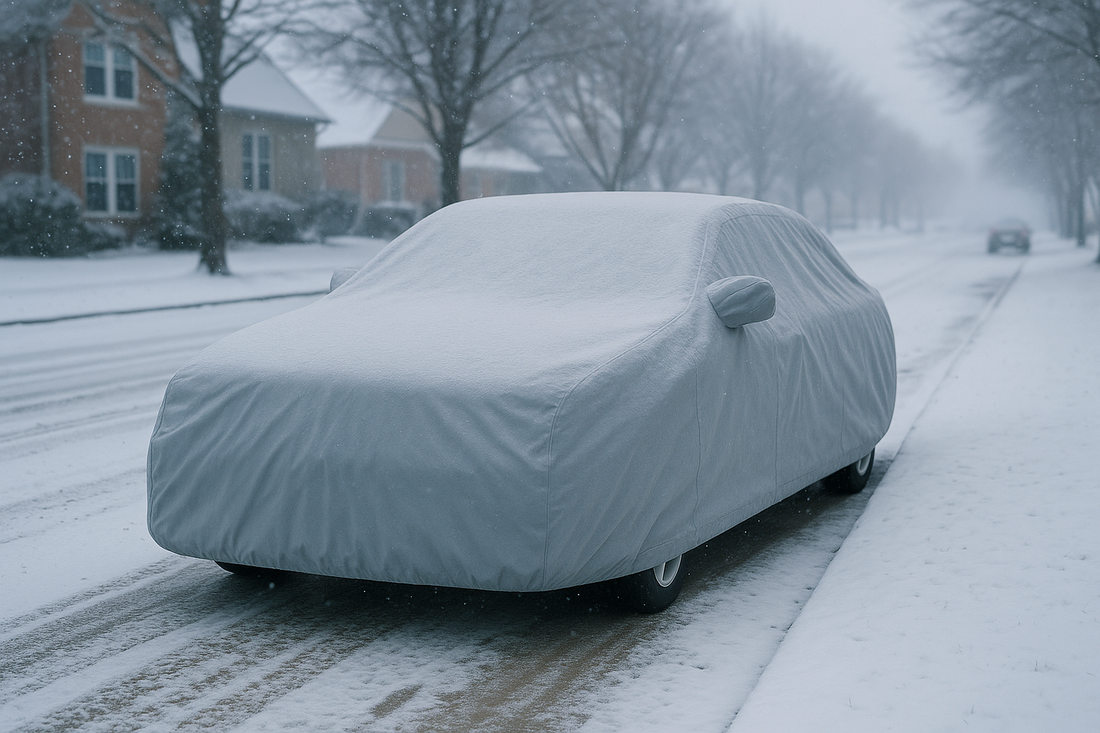Shielding Against Salt & Grit: Winter Cover Strategies That Save Paint
Why Salt & Grit Wreck Finishes
Winter isn’t just cold—it's corrosive. Road crews spread salt (and other de-icers) that dissolve into brine, creep into seams, and attack metal. Meanwhile, sand and micro-grit act like fine sandpaper across your clearcoat. The combo dulls gloss, seeds rust, and accelerates paint failure—especially on lower doors, rocker panels, and the front fascia.
What the Right Cov![]() er Must Do in Winter
er Must Do in Winter
1) Block brine and slush—yet breathe
A winter-ready cover should pair a water-resistant outer shell with breathable construction so interior humidity can escape. That prevents clammy condensation and water spotting on cold mornings.
2) Protect paint with a soft liner
A soft, anti-scratch inner face cushions against incidental grit and helps avoid micro-marring when temps drop and clearcoats become brittle.
3) Stay put in wind
Look for elastic hems, under-body straps, and grommets to prevent flapping (flapping = friction). A snug, contoured fit reduces slack that traps debris.
BestFit® Picks for Salt & Grit Season
- BestFit® All-Weather HD — Heavy-duty, multi-layer shield for daily outdoor parking in salty, slushy conditions.
- BestFit® All-Weather — Robust all-rounder for mixed snow, occasional storms, and regular commute use.
- BestFit® SunGuard — Balanced protection where winter brings bright sun plus light precipitation (great breathability).
- BestFit® Basic — Indoor/covered-parking option to keep dust off and prevent incidental rubs.
How to Use a Winter Cover the Right Way
Before installation
- Quick rinse to remove salt film and road grit (especially lower panels). Don’t trap residue under the cover.
- Dry thoroughly, including mirrors and trim, to avoid freeze-bonding overnight.
- Optional protection: apply a sealant or wax to high-exposure zones for an extra barrier beneath the cover.
Daily winter routine
- Fit front to back and secure straps—less movement = less abrasion.
- After a storm, brush off snow gently before removal. Don’t drag the cover across salt-loaded surfaces.
- Shake out accumulated grit weekly; spot-rinse the outer shell if you see salt crystals.
Cleaning & care
Wash the cover every few weeks with mild soap; rinse thoroughly and air-dry before reuse. A clean cover equals a cleaner finish—especially in salty climates.
Common Mistakes to Avoid
- Covering a dirty, salty car. Always rinse first.
- Using a non-breathable tarp. Trapped moisture + cold metal = water spots and corrosion.
- Skipping strap checks. Wind flap is what turns dust and grit into scouring pads.
Quick Reference: Which Cover for Which Scenario?
| Scenario | Recommended Cover | Why |
|---|---|---|
| Daily outdoor street/driveway parking in salted areas | All-Weather HD | Max barrier vs. brine, slush, and grit; reinforced security |
| Mixed sun, light snow, occasional salt | All-Weather | Balanced defense; easier daily handling |
| Carport or mild winters; prioritize breathability | SunGuard | Great vapor escape; guards against UV + light debris |
| Indoor storage during storm cycles | Basic | Protects from dust and incidental contact |
Helpful Links
FAQs | Shipping Policy | Refund Policy | Size Chart
Protect Your Finish All Winter
Salt and grit don’t have to win. Pair smart wash habits with a fitted, breathable winter car cover and you’ll glide through the season with glossy paint and clean trim.
Ready to gear up? Shop BestFit® All-Weather HD, explore All-Weather, or compare SunGuard & Basic now.

